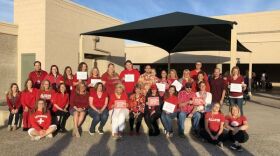A research team at Embry-Riddle Aeronautical University in Prescott has received a first of its kind grant to test building materials against weapons. The goal is to see what works best for delaying an active school shooter. As KNAU’s Justin Regan reports, it’s a more passive style of security that uses the architecture itself as a barrier.
Mark Sorensen is the President and CEO of the STAR School near Leupp on the Navajo Nation. It’s more than 20 miles from the nearest emergency services. So if a school shooting were to happen, help would probably be a long time coming.
"I think most plans that I’ve seen put out there for schools generally rely on police arriving on the scene very quickly," says Sorensen. "And obviously we have to come up with another plan."
He says the small, rural school can’t afford an armed guard, and metal detectors would give the campus a prison-like feel.
"I know that some people are thinking their needs to be different solution than just hunkering down and staying in place," says Sorensen.
Tom Foley is working on a different solution. He’s an assistant professor in security and intelligence at Embry-Riddle. His research team has just received a grant from the U.S. Justice Department to better understand what architectural designs and materials offer the most protection.
"This project involves testing various barrier materials against several different caliber weapons, the most commonly used in mass shootings," says Foley. "To determine how long those barrier devices will remain in place against a ballistic and forced entry attack."
The study will focus on doors, windows and locks. Foley says most school buildings are outdated and budgets don’t include top of the line security features. His study will involve more affordable materials.
"You can take a temper glass window, smack it with a hammer, it is going to crumble and fall out of the frame," says Foley. "You take that exact same temper glass window and put a film on it, you may have to smack it with a hammer for a couple of minutes before you’re able to get through the window."
Foley also believes some manufacturers profit from tragedy, pedaling expensive safety products to fearful buyers. He hopes this study will help school officials make more scientifically-backed security decisions.
"Most people think guns, gates, guards. And it’s much more complicated than that," says Foley. "So what we hope to do is get information out there. So the decision makers and influencers are approaching the problem from a position of knowledge versus a position of fear."
Austin Eubanks knows that fear. He was shot while hiding under a table in the library of Columbine High School 19 years ago. That’s when two students killed 13 people including Eubanks’ best friend. He says a study like the one at Embry-Riddle is a step forward.
"We have to start somewhere. I think the architecture is a really important place to start, says Eubanks. "The idea behind that is you’re just looking to delay what would be an assault from a perpetrator."
But like everyone interviewed for this story, Eubanks believes the solution is far more involved than shatter-proof glass and steel plated doors.
"And so we have to start looking at the psychology of the person and finding ways to spot a likelihood of this and be able to bring that person into a feeling of community and connection, to start to have these conversations, to hopefully cut it off before it starts. But that’s not a quick solution," says Eubanks.
The Embry-Riddle research team is working with schools, students and parents across the state, collecting data about the architectural side of security.







